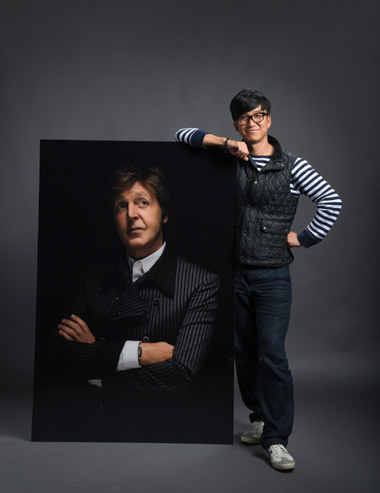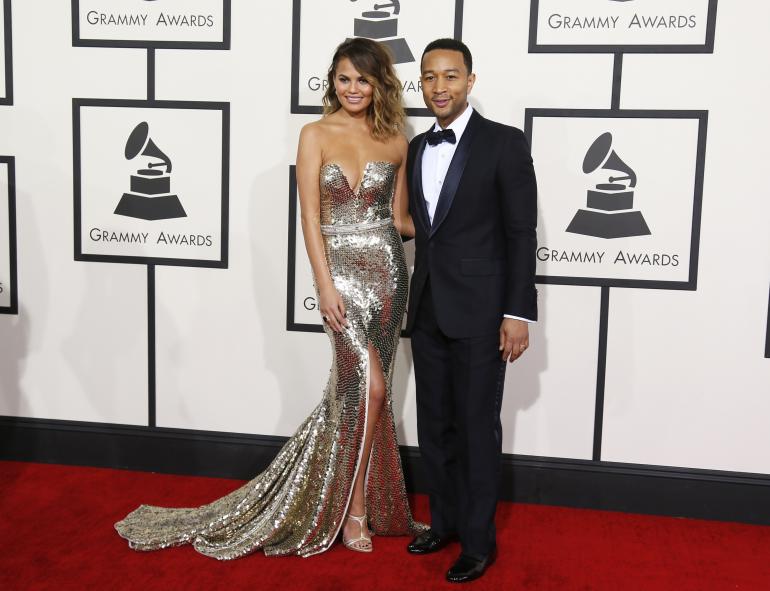MJ Kim captures and creates stunning images of some of the world’s biggest stars—the biggest, of course, being Sir Paul McCartney.
story and top photograph by MARK EDWARD HARRIS
Gracing the walls of MJ Kim’s Hollywood photography studio are images of the “who’s who” of the music and entertainment industry: Sting, Johnny Depp, Natalie Portman, Victoria Beckham and Justin Timberlake are among the many framed pictures. And, then there’s a larger-than-life portrait of Sir Who’s Who himself: the legendary Paul McCartney.
Kim began working with McCartney in 2008, and then became his personal photographer the following year. In addition to documenting all of the singer’s personal projects, he follows the former Beatle as he tours the world—including on the current “Out There” tour, which kicks off its U.S. leg this month. “It is quite amazing to see 50,000 multi-generation people—I mean from 3 years to 100 years old—just enjoying the same music together!” said Kim, referring to the crowds that the 72-year-old McCartney commands. “It is such a pleasure to witness, and capture the love and harmony.”
You might say it was a long and winding road (shameless Beatles reference intended) that brought Kim, a native of South Korea, to his current position as an international photographer who has worked with some of the biggest names in the arts. The lensman, who moved to L.A. in 2010 after 15 years living and working in London, sat down with photojournalist Mark Edward Harris last month to elaborate on that eventful path.
MJ Kim follows Paul McCartney around the globe, documenting the legendary singer as he entertains his crowds (top) in Regina, Canada, and (bottom) in New York. (Photos: © MJ Kim.)
How did you end up working with Paul McCartney?
While I was a senior entertainment photographer for Getty Images, I covered a lot of international events, such as the Cannes, Venice and Berlin film festivals and many movie junkets. I built a lot of relationships with public relations and artists’ management companies during that time. That helped when I went freelance at the end of 2007.
The first assignment I got as a freelancer was to photograph the Spice Girls for four months on their reunion tour. The publicist working for the Spice Girls, Stuart Bell, was also Paul McCartney’s publicist. So after the tour, he had Paul look at my work. He liked it, and we’ve been working together since 2008.
What have been some of the highlights of working with Paul over the last six years?
There have been so many. Paul and the crew, we’re like a family. I went with Paul to the White House when he was given the Gershwin Award by President Obama in 2010. We had a little concert in the White House. The guests included Obama’s family, congressmen, about 200 people. It was an amazing show and an amazing experience. Another one was the London Olympics [in 2012], where Paul closed the opening ceremonies with “Hey Jude,” and I was on stage with him. He was very excited. I was very excited. The world was very excited.
What’s your favorite McCartney song?
“I Saw Her Standing There.” I love, love, love that song. It’s so fun. It’s got such a classic rock ‘n’ roll rhythm and the story is really cute. The story reminds me of my youth in Korea. “Well she was just 17, you know what I mean, and the way she looked, was way beyond compare …”
As for an album, I love Abbey Road. Some of the songs were by Paul, some by George Harrison, some by John Lennon. Every song has such a beautiful character.
What would you say you’ve learned after many years of documenting this one person—essentially, a living legend?
One, nothing is more important than family. Two, be humble. Three, keep pushing yourself and never compromise.
What attracts you to photographing musicians?
On stage musicians produce amazing energy, which you cannot expect from a studio session. It only comes out on stage. During the live performance, you can capture that energy, but you don’t have any control. In that situation, I’m a photojournalist using my Canon 5D Mark IIIs to capture what’s happening in front of my lens. In the studio, I can influence the image by my lighting and my direction of the person. Both approaches are very different, but equally fascinating.
Johnny Depp (© MJ Kim)

MJ Kim, with Jonny Depp. (Photo Courtesy of MJ Kim)
Where does your dramatic use of light for studio portraiture come from?
There’s an expression in Italian, “chiaroscuro,” which means the use of strong contrasts between light and dark. I start in the darkness and build the light, bit by bit. I use light-modifying tools, such as beauty dishes with grids. An early inspiration for lighting for me was not a photographer, but the 16th-century painter Caravaggio. It’ s similar to Rembrandt lighting, but more dramatic. I like a bit of dark, moody lighting.
You also on occasion use the larger 8-by-10 camera that takes a prominent position in your studio. It’s almost an objet d’art.
I’ve been using the 8-by-10 Kodak Eastman 2D view camera for shooting a new series with wet plate Collodion. Part of the reason I like it is because it is bloody hard. When I first started school in London, I shot film. When you shoot film, it’s money. You have to buy film, paper and so on. Every shot is important. I love the technology of the digital revolution but everything is so easy—it’s too easy. Too many images. So when I discovered this 19th-century wet plate process, I fell in love with it. You have to prepare the chemicals and put them on the plate, then expose the image, then process it. You do everything. Sometimes it works, sometimes it doesn’t. I love this analog process. I love the texture of it. The originality. Once you make a plate, that’s it. The color is in-between black and white and sepia, and the edges have a very mysterious look to them.
What took you to London to study photography?
In 1995, at the age of 22, I went there to study filmmaking, actually—not photography. When I was in Korea, I worked in the TV industry a little, but never thought about being a photographer. While I was studying film in London, I was aware of the many similarities between film and still photography. So I bought a couple of books on photography to study on the side and borrowed an old Pentax camera from my roommate that he had sitting in the closet. The more I took pictures, the more I fell in love with still photography.
 Matthew McConaughey (© MJ Kim)
Matthew McConaughey (© MJ Kim)

David and Victoria Beckham (© MJ Kim)
How did that evolve into a career?
While I was in London, there was a huge economic crisis in Korea in 1998, so my parents couldn’t support my studies any longer. I stopped my film studies at the university and started working as a photographer trainee at a small news agency in London. I was just trying to survive in the U.K. There were four trainees in the agency; I was the only foreigner. At the end, they hired a British guy and me as full-time photographers. The agency specialized in court cases. In the U.K., you cannot take cameras inside the courtroom by law, so our agency was photographing people involved in big cases going in and out of court.
I worked there about a year, then got a freelance job shooting for the Daily Telegraph also for about a year, then went to work for the Press Association, which is like the Associated Press in the U.S. Eventually Getty Images in London offered me a position as senior entertainment photographer. I was with them in that position from 2004 to 2007. In 2008, after years of working in the photography field and after recently starting to work with Paul, I went back to school to get a master of arts degree in fashion photography at the London College of Fashion. I did not have to first finish my B.A. because of all my practical experience in photography.
By that time you had an amazing gig and had already achieved so much in your career. What made you feel you needed additional time in school?
Definitely not the technical fundamentals. I was seeking the answer to the question of what I was taking pictures of, and what was the definition of a beautiful picture. I was becoming more and more interested in portraiture.
I knew how to do live action shoots because I was a news photographer. That was good, but at the same time, I wanted to create my own images, but I didn’t know how. So I decided to go back to school and learn. It was one of the best decisions I ever made. I was in school and working at the same time.
I think you can learn technique, such as studio lighting, fairly quickly. But I think the more important thing to learn is the understanding of what’s behind the images, why you think this image is beautiful, why you want to create these kind of images. I had a lot of why’s, question marks in my head. That’ s why I decided to go back to school.
And did the experience in school answer most of them?
Yes, and maybe the most important one: getting a reference before the shoot. When I did a portrait session with someone before I went back to school, I just wanted to create a beautiful image, but didn’t really appreciate what a beautiful image was. I didn’t know how to prepare a shoot. I learned that in school. I also learned to look at not just photography, but painting and architecture as visual inspirations. It was in school that I learned about Caravaggio. I could then apply this awareness to the images that I wanted to get. I gained much more depth in photography at the London College of Fashion.
For my final project for my master’s degree, I asked [Paul’s daughter] Stella McCartney if I could use some of her dresses. She’s a great designer. The series is on the resurrection of the fashion soul. The concept was that the girl was laying down wearing a white plain gown representing her death in real life. But when she’ s resurrected, she’ s wearing Stella’s dress and has full makeup and hair. She’s resurrected with a fashion soul.
Photos: © MJ Kim
A more recent collaboration has been with your wife (with whom you have two children). What’s that about?
My wife Jessica is an illustrator. She got a lot of inspiration from the Grimm Brothers and their stories and suggested that we re-create classic storybooks with personalized photos. Children come to our studio and pick costumes we have here from their favorite classic stories—Snow White, Alice in Wonderland, Pinocchio, Little Red Riding Hood, Cinderella, Hansel and Gretel, The Little Prince, Jack and the Beanstalk. They are copyright-free. I photograph the children dressed in character, having them pose in positions that relate to the story. Once the pictures are done, Jessica and her team create the illustrations and then have books printed. We can also make canvas prints.
Working with Paul and other celebrities is an amazing thing, but it’s a totally different joy. Making a book for people’s children, the pure joy and happiness [the families] get from the book, and the experience, make my wife and me really happy.
This article was published in the July 2014 issue of KoreAm. Subscribe today! To purchase a single issue copy of the June issue, click the “Buy Now” button below. (U.S. customers only. Expect delivery in 5-7 business days).
















